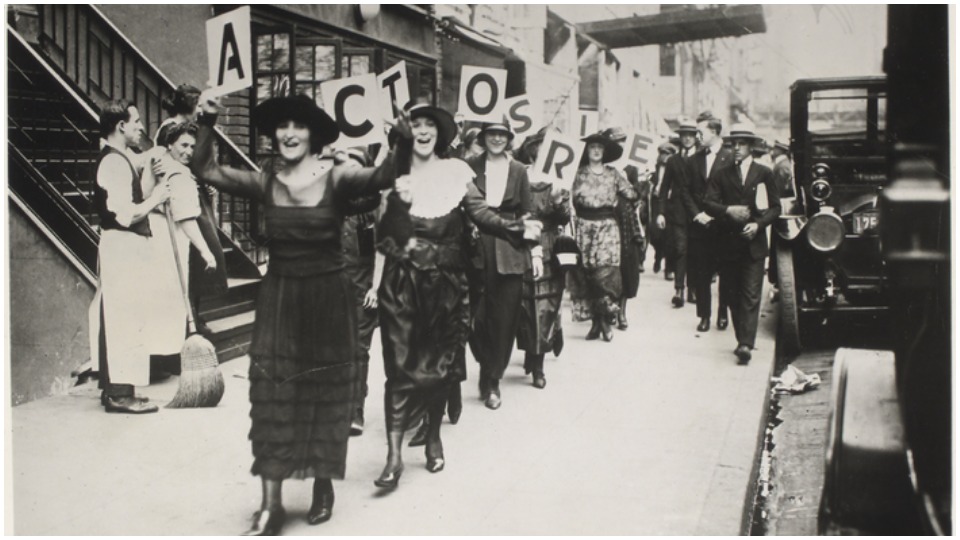
The Communist Party USA was founded in the middle of a year of intense and militant workers struggle. From coast to coast in 1919, and among workers in a wide variety of industries, the U.S. working class stood up for its rights and for the dignity of labor. It was met at every step by the forces of capital, be it through court orders or the armed might of the police and the military. Some workers won victories, but often the forces of repression brought about defeat. The flame of righteous struggle, however, could never be extinguished. This is the second of a 3-part series in which David Cavendish analyzes some of the major strikes of this pivotal year in U.S. labor history. Read Part 1.
“Strike!” An Actors Equity Production
August 18, 1919, was a rainy day in New York City, and as Robert Simonson wrote in American Theatre magazine, “the best stage show in New York wasn’t on Broadway.” It was at the Lexington Avenue Opera House where 150 members of Actors Equity Association, the union representing actors and stage managers, were presenting a fundraiser for their members, who, eleven days earlier, had gone on strike and closed many of the legitimate theaters.
A sold-out house with 500 standees enjoyed a show by some of the biggest names on Broadway, none of whom were being paid. As Simonson described, “The show was the first of a week of benefit performances put together by the union…. Marie Dressler taught hoofers a dance routine in about a quarter of an hour. W. C. Fields acted as master of ceremonies. Lionel and Ethel Barrymore performed the second act of The Lady of the Camellias. Eddie Cantor took the stage and joked that for once he was making as much as Ethel Barrymore. Eddie Foy and his various children performed. Silent film star Pearl White expressed delight at getting the opportunity to talk.”
The rise of industrialization saw the development of theatre production as a big business. Centered on Broadway in the Times Square area of New York, by 1919 some of the best-known actors in the country worked in dozens of theaters in well over one hundred plays and musicals a year.
Despite the fame and glamor of some actors, working conditions for most of their colleagues, as well as stagehands and musicians, were deplorable. According to one writer, the performers were nothing more than indentured servants. They had to take part in weeks of rehearsals (ten for a play, eighteen for a musical) at no pay. Nearly all had to purchase their own costumes, which at a time when costumes were a major part of these productions proved to be a “crippling expense.” Plus, they had to pay their own hotel bills.
To make matters worse, during certain weeks, such as the Christmas and New Years holidays, they were paid only half their regular salary. Contracts included twenty-five additional clauses that covered a panoply of moral and behavioral requirements, such as the use of liquor in their dressing rooms. Any behavior “unbecoming ladies and gentlemen” could lead to forfeiture of their total pay for the engagement.
Fed up with these working conditions, 112 actors founded their union, the Actors Equity Association (AEA) in May 1913. The producers remained intransigent and refused to improve working conditions. In August 1919, more than 1,500 actors met at the Hotel Astor and decided to walk off the job, an action which brought in an additional 1,200 new members.
2019 marks a century since the founding of the Communist Party USA. To commemorate the anniversary of the oldest socialist organization in the United States, People’s World has launched the article series: 100 Years of the Communist Party USA. Read the other articles published in the series and check out the guidelines about how to submit your own contribution.
On the evening of August 7, the casts of twelve shows refused to go on stage. Within two weeks, virtually every show in New York was closed. Strikes spread to Chicago, where in a matter of days, all theaters were dark. The strike moved next to Washington, D.C., Boston, and Philadelphia, as well as smaller cities.
The producers saw their income dry up, and by early September, they agreed to recognize the union and gave in to many of its demands. In addition to actors, stagehands and musicians also made important gains.
(As an aside: It should be noted that George M. Cohan, the songwriter and actor, who became one of the biggest names on Broadway, never joined Actors Equity. He reportedly said, “Before I will ever do business with the Actors’ Equity Association, I will lose every dollar I have, even if I have to run an elevator to make a living.”)
Women’s wear and women’s wages
Only a few blocks away from the glitz and glamour of Broadway lay the grit and solidity of the Garment District, the center of the ready-to-wear clothing industry. One of its major components was the production of ladies garments. From humble origins, by the early part of the twentieth century, it had become an important part of the national economy. Its workers, largely Jewish and Italian immigrants were young women, some no older than girls. They worked long hours in either large factories or in crowded, poorly ventilated factories known as sweatshops.
The industry was highly fragmented with a few large businesses (the “inside manufacturers”) and many contractors, “jobbers,” many of whom operated so as to squeeze every last ounce of production from their employees. Fire was always a danger, as seen in March 1911 when a major conflagration broke out at the Triangle Shirtwaist Factory, where 146 women and girls died.

After new laws were passed, conditions improved, but not greatly. In response, the workers in the women’s clothing industry organized themselves into a new union, the International Ladies Garment Workers Union (ILGWU). Over the years, they repeatedly went on strike and made important gains, but problems remained.
By January 1919, the workers had had enough and at a mass meeting at Madison Square Garden voted to strike. They demanded better working conditions, higher wages, and shorter hours. According to Justice, the union newspaper, the ensuing strike by “tens of thousands of women workers” showed “indefatigable courage and self-devotion.” Their militancy was reflected in the fact that more than 3,500 women were arrested for peaceful picketing. Production in the industry nearly came to a complete stop.
The owners, fearing that they would lose all sales for the season and faced with a unified and defiant workforce, capitulated. They conceded virtually every union demand, including the 44-hour week.
Police to the pickets—as workers, not strikebreakers
A person living today would probably have a hard time imagining police officers going on strike. Most of us see the police as breaking strikes, not starting them. In Boston, 1919, conditions were very different.
For years the Boston police worked under terrible conditions. They labored long hours and received low pay. They were required to pay $200 to buy their uniforms. One source says a police officer received only half of the pay of a construction worker. At times, after their shift was completed, they were required to stay at the station house for another shift. In addition, police work is stressful, which, when added to the physical demands, made the job very difficult. As a result, the officers began to push for some reforms, but their pleas fell on deaf ears.
In August 1919, they formed the Boston Policemen’s Union and received a charter from the American Federation of Labor. The police commissioner, in response, suspended eight union leaders. The next day, September 9, 1919, the union went on strike.

The action, however, was a fiasco. Incidents of lawlessness in the streets broke out almost immediately, which undermined public support. No public official supported the strike, and the governor of Massachusetts, Calvin Coolidge, mobilized the National Guard to maintain order. Samuel Gompers, president of the AFL, telegraphed Coolidge suggesting a compromise: The police would return to work if the city would work to resolve the main issues. In response, Coolidge issued a statement: “There is no right to strike against the public safety by anybody, anywhere, anytime.” The strike collapsed.
The post-script is familiar to any student of American history. Coolidge’s stand, which sounds eerily like what we often hear today, was a major factor in his being nominated as vice president on the Republican ticket in 1920. When President Warren G. Harding died in 1923, Coolidge became the thirtieth president of the United States.
These three strikes were only three of many local work stoppages across the country. Workers in industries of national scope were equally militant. Three strikes, the Seattle General Strike, the Coal Strike, and the Great Steel Strike of 1919 would unfold in dramatic fashion during the year.










